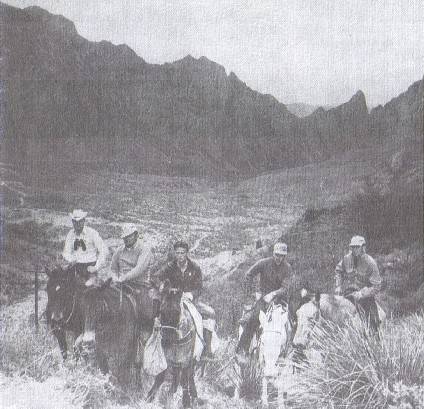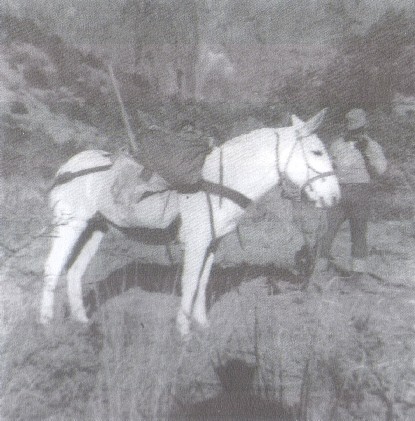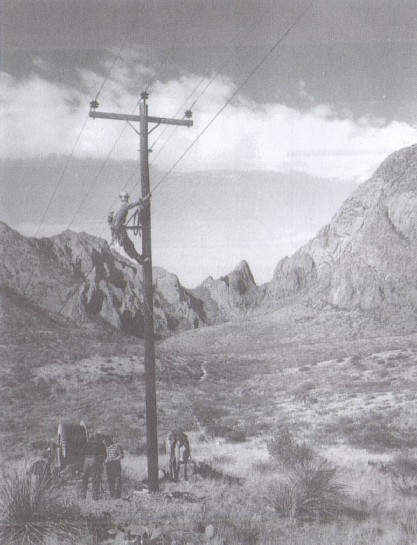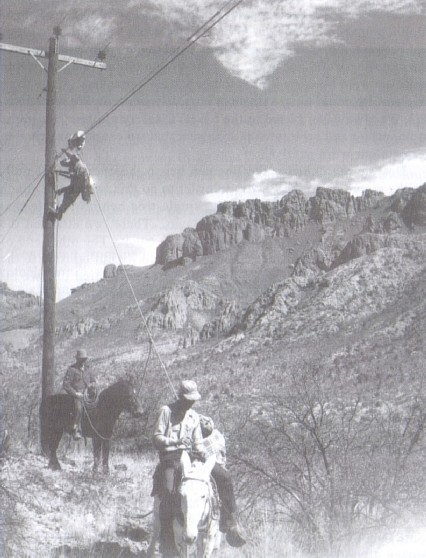The Telephone Comes to Big Bend National Park
by Carl Rusk
Reprinted from "Crown Jewels of the Wire", September 2002, page 16
Ed. Note: Many of you remember Carl Rusk...he was a friend to most
of us and he was a special friend of mine! One of the many things I'll remember
about Carl was his prolific ability to put together fantastic exhibits. These
were great presentations of various facets of the insulator hobby. Almost
always, his displays would win awards. At the NIA Western Regional in Albuquerque
a few years ago, Carl did a display of the wiring of Big Bend National Park, and
true to form, he won the Best of Show award. Over eighteen months ago, I took
his notes and display material form this exhibit and put it all in "story
form". In turn, Carl "fixed" this version and sent it back to me
in March, 2001. Carl won't be able to read the final product, because we
couldn't get it into print before he passed on in July, 2001. So this is in his
memory.
-- Tom Katonak
One of the truly scenic areas of our nation is the Big Bend country deep in
southern Texas. This land is named for the huge bend in the mighty Rio Grande
that forms the boundary between the United States and Mexico. Here the vast
deserts and the craggy mountains dominate the vistas of a desolate but
spectacularly beautiful landscape.
When the Big Bend National Park was
established in 1944, the only communications the Park personnel had with the
outside world were either by radio or by travel to Marathon or Alpine, Texas
over rough, dusty ranch roads. In order to make a long distance telephone call,
park personnel had to travel the 80 miles of rough road to Marathon to find a
telephone.
About 1954, Southwestern Bell Telephone Company, in cooperation with
the Rio Grande Power Company and the Big Bend National Park officials made plans
to construct the first telephone line from Alpine and Marathon into the National
Park headquarters and from there, on into the Big Bend Basin. The plan would be
carried out in three stages.
First, there would be a toll line constructed from
Alpine to Marathon. This line would consist of eight new wires on newly set
poles over a distance of some 30 miles. The next stage called for the construction
of a new live-wire line from Marathon to the Big Bend National Park
Headquarters, a distance of about 80 miles. And finally, a joint construction
project would add telephone cable to the existing poles of the Rio Grande Power
Company.
In order to accomplish this extensive project, the planners had to
choose a seasoned telephone construction crew used to working in desert
conditions. The Alpine construction crew fit those qualifications. This crew
consisted of me, the construction foreman, and six linemen: J.L. Jones, D.K.
Wilson, L.G. Crestman, C.L. Gibson, A.G. Henderson, and F.E.
"Dynamite" Eiden. With plans complete and with the notification of our
next job, my crew and I began the huge job of rounding up equipment and
obtaining needed supplies for the big project.

Carl Rusk (far left), the construction foreman, and four of
his six linemen:
J.L. Jones, D.K. Wilson, L.G. Crestman,
C.L. Gibson pictured on the cover of
Southwest Holiday,
Vol. 9, No.4, April 1955.
The first stage in the construction began with building a new eight-wire line
on the 30-mile stretch between Alpine and Marathon. When that was completed in
the usual amount of time, the second phase of the construction began with the
building of another new line from Marathon to the Big Bend National Park
Headquarters. This operation meant that we had to set 701 new poles! We attached
brackets to the poles while they were still on the ground, and then hoisted the
"dressed" pole into the hole dug for this purpose, and tamped or set
it. Then we strung two wires onto the pole line all the way to Park
Headquarters. We were used to working in this routine order and we had trucks,
trailers, and other equipment to aid us to do the best job possible in the least
amount of time. However, we were to find out that even routine construction
could become a challenge under certain conditions. We soon found out what these
"certain conditions" were!
When we reached Persimmon Gap, the Park
officials told us that we could not take all of our construction trucks and
trailers onto park lands unless a Park Ranger accompanied us to advise us on
environmental regulations! The Park officials and the construction foreman and
crew had a short conference, and we decided that only a single truck carrying
the telephone poles would be allowed to travel along the designated telephone
line easement route. This truck must use the same route on its return trip. We
did exactly as we had planned, and the first day we had 21 flats on that
pole-hauling truck. For those of you that know something about the greasewood
bush common to the area, you know that once the stems are broken, the remaining
stalks become as sharp and deadly as steel spikes. So, we decided to look for a
way to get those poles into position by the dug holes without having to fix so
many flat tires!
After another lengthy discussion, we decided to have the poles
hauled by truck to designated locations, and then we would take the mule team
and pull the poles to the holes, leaving a minimum of damage to the land and to
the truck tires! B.B. "Bert" Beckett, who operated a Park concession
for horseback riding and pack mules, furnished the teams of mules and horses.
His pack mules carried our tools, smaller equipment and other supplies into the
working area. The foreman and crewmembers rode horseback instead of riding in
telephone trucks. The "horse bill" for this project was about $1,175.
This was an unusual expense for a Southwestern Bell Telephone Company
construction crew to turn in, and it precipitated a number of questions when the
paperwork hit the central accounting office!

After all the poles were set in the ground, complete with the brackets, we
started the next operation of stringing a number 104 copper-steel wire onto the
brackets. This operation offered another challenge. Because the trailer load of
two rolls of wire was too heavy for the mules to pull, we decided that a single
power truck would haul the trailer over the same route that all the mule teams
and horses had followed previously. We had to have that special-built trailer to
enable us to unwind two coils of wire at the same time as the truck pulled the
trailer slowly along the pole route. In this manner, the wire was unwound and
laid out on the ground beside the poles. We had learned our lesson by now, and
we had the power truck equipped with puncture-proof tires!
After all of the wire
was unreeled and the ends "made fast", the linemen took long poles
with forked ends, called "lay-up sticks", and they pushed the wire up
onto the brackets. When the wire was in the bracket, we pulled the wire through
30 poles at a time. Then we cut each one and tied the loose end around the
bottom of the next pole. Next we would take the other loose end of the wire and tie it
around the bottom of the same pole. The linemen again pushed the wire up onto
the brackets for the next 30 poles. When all the wire was strung out, we went
back to the "tie-off", attached blocks and started the
"sagging" operation that resulted in the same amount of sag in the
wire between each of the poles. This operation required cooperation between
linemen on opposite ends of the line being worked. We repeated this procedure
until we finally reached the Park Headquarters.

After the telephone wires were up and sagged, I always made a test-call to
the operator in Marathon on a field test set that hooked directly onto the
telephone wire. (This same test set is still in my collection of old telephone
equipment today.) In the latter part of 1954, and on a day when I was making one
of these test-calls, Mr. Blakey of the National Park Concessions came by and
told me that he had to drive 80 miles to Marathon to make a long distance phone
call to his headquarters at Mammoth Cave, Kentucky. I asked him if he would like
to make the call from right here. Surprised, Blakey asked how he might be able to do this. So I showed him how the test-set
worked and he said, "Sure, let's try it!" I called the telephone
operator in Alpine and asked her to connect me with the Mammoth Cave
Headquarters in Kentucky and gave her their number. She did this directly, and
Mr. Blakey proceeded to make the first long distance call from the Big Bend
National Park Headquarters on the newly constructed line.

From the Park
Headquarters to the Basin, Southwestern Bell Telephone Company joined in
agreement with the Rio Grande Electric Company to use the power company's poles
for placing cable into the Basin. We used a heavy strand with a breaking
strength of 10,000 pounds on the power poles. There was a space of about four
feet between the 7200-volt power line and the telephone strand. We had to quite
careful not to let the strand jump up into the power line while we were hooking
it onto the power pole brackets. If we were careless, we could have a lineman
critically injured! We were careful! We always paid heed to the SWBTC safety
motto: "No job is so important and no service is so urgent that we cannot
take time to perform our work safely!"
Despite the dangers, the linemen
began the operation of pulling the strand up to the Basin. In order to do this,
we had to attach a wire, called a "fishwire", to the single-tree
behind a mule that pulled the wire all the way to the Basin. There, we attached
the wire to a winch line on a telephone winch truck. The other end of the "fishwire"
was attached to the strand and we pulled it up to the Basin with the winch
truck. After the strand was tied off, we attached the "fishwire" to
the large telephone cable itself. However, before we could pull the cable up to
the Basin, we had to hook "dollies" onto the stretched strand, about
every eight feet. These "dollies" were actually large hooks that fit
over the strand and contained a smaller hook on the other end big enough for the
cable to be pulled through parallel to the support strand. At this point, we
would have to use a piece of equipment called a "lasher" attached to
the strand. As the "lasher" rolled along the strand, it pushed the
"dollies" ahead of it until a crewman could remove them. As the
"lasher" moved ahead, the back part of the contraption wrapped lashing
wire around the strand and the cable, thus giving the telephone line permanent
support. We collected all these "dollies" and placed them back in the
pack on the white pack mule. Therein lies another story.
Bert Beckett had warned
the lineman nicknamed "Dynamite" not to ever touch the ears on that
white mule, but in reaching out to replace a "dolly" in the pack, he
accidentally touched the mule's ear! Well sir, that white mule surely did put on quite a show! He started
pitching and running and unloaded every darn "dolly" from his pack.
After "Dynamite" finally caught him, he had to pick up and reload all
those "dollies"! Needless to say, he was very careful after this event
not to touch the white mule's ears!
With the telephone cable in place from Park
Headquarters to the Basin, it was time for the crew of cable-splicers to come in
and connect the ends of the cable. After the splicing was complete, the phone
installers came with their equipment and put in the actual telephones. Finally,
the new phone line from Alpine and Marathon into the Big Bend NP was complete
and ready for communications to and from the outside world!
For the first time
in the history of BBNP, park personnel or visitors alike would no longer have to
drive that long rough road into Marathon to make a long distance call. In April
of 1955, all of the people involved with this project got together in the Basin
for a big celebration: Speeches were made, awards were given to individuals and
groups, experiences were exchanged...and thanks were given to all concerned. The
primary thing that I was thankful for was that we had completed a challenging
and often dangerous project without a serious accident to the workers and the
telephone crew, and...without any lasting damage to the parklands.
|
